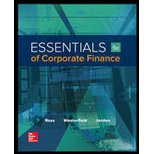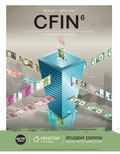
ESSENTIALS CORPORATE FINANCE + CNCT A.
9th Edition
ISBN: 9781259968723
Author: Ross
Publisher: MCG CUSTOM
expand_more
expand_more
format_list_bulleted
Question
Chapter 17, Problem 17.5C
Summary Introduction
To determine: The total annual carrying costs.
Introduction:
Costs refer to the amount of money a firm spends on the production of goods or services. This amount is not included in the mark-up of profit.
Carrying cost is also termed as holding cost. Carrying cost increases with the level of investment in current assets; this is inclusive of other costs like
Expert Solution & Answer
Want to see the full answer?
Check out a sample textbook solution
Students have asked these similar questions
Replacement Analysis
The Everly Equipment Company's flange-lipping machine was purchased 5 years ago for $75,000. It had an expected life of 10 years when it was bought and its remaining depreciation is $7,500 per year for each year of its remaining life. As older flange-lippers are robust and useful machines, this one can be sold for $20,000 at the end of its useful life.
A new high-efficiency digital-controlled flange-lipper can be purchased for $130,000, including installation costs. During its 5-year life, it will reduce cash operating expenses by $45,000 per year, although it will not affect sales. At the end of its useful life, the high-efficiency machine is estimated to be worthless. MACRS depreciation will be used, and the machine will be depreciated over its 3-year class life rather than its 5-year economic life, so the applicable depreciation rates are 33.33%, 44.45%, 14.81%, and 7.41%.
The old machine can be sold today for $50,000. The firm's tax rate is 25%, and the…
The Gilbert Instrument Corporation is considering replacing the wood steamer it currently uses to shape guitar sides. The steamer has 6 years of remaining life. If kept, the steamer will have depreciation expenses of $700 for 5 years and $350 for the sixth year. Its current book value is $3,850, and it can be sold on an Internet auction site for $4,440 at this time. If the old steamer is not replaced, it can be sold for $800 at the end of its useful life.
Gilbert is considering purchasing the Side Steamer 3000, a higher-end steamer, which costs $12,300, and has an estimated useful life of 6 years with an estimated salvage value of $1,200. This steamer falls into the MACRS 5-years class, so the applicable depreciation rates are 20.00%, 32.00%, 19.20%, 11.52%, 11.52%, and 5.76%. The new steamer is faster and allows for an output expansion, so sales would rise by $2,000 per year; the new machine's much greater efficiency would reduce operating expenses by $1,800 per year. To support the…
St. Johns River Shipyards' welding machine is 15 years old, fully depreciated, and has no salvage value. However, even though it is old, it is still functional as originally designed and can be used for quite a while longer. A new welder will cost $181,500 and have an estimated life of 8 years with no salvage value. The new welder will be much more efficient, however, and this enhanced efficiency will increase earnings before depreciation from $28,000 to $78,500 per year. The new machine will be depreciated over its 5-year MACRS recovery period, so the applicable depreciation rates are 20.00%, 32.00%, 19.20%, 11.52%, 11.52%, and 5.76%. The applicable corporate tax rate is 25%, and the project cost of capital is 13%. What is the NPV if the firm replaces the old welder with the new one? Do not round intermediate calculations. Round your answer to the nearest dollar. Negative value, if any, should be indicated by a minus sign.
Chapter 17 Solutions
ESSENTIALS CORPORATE FINANCE + CNCT A.
Ch. 17.1 - Prob. 17.1ACQCh. 17.1 - Prob. 17.1BCQCh. 17.1 - Prob. 17.1CCQCh. 17.1 - Prob. 17.1DCQCh. 17.2 - Prob. 17.2ACQCh. 17.2 - Prob. 17.2BCQCh. 17.2 - Prob. 17.2CCQCh. 17.2 - Prob. 17.2DCQCh. 17.3 - Prob. 17.3ACQCh. 17.3 - Prob. 17.3BCQ
Ch. 17.3 - Prob. 17.3CCQCh. 17.4 - Prob. 17.4ACQCh. 17.4 - Prob. 17.4BCQCh. 17.4 - Prob. 17.4CCQCh. 17.5 - Prob. 17.5ACQCh. 17.5 - Prob. 17.5BCQCh. 17 - If a firm receives a check for 50,000, its...Ch. 17 - Prob. 17.2CCh. 17 - Prob. 17.3CCh. 17 - What are shortage costs?Ch. 17 - Prob. 17.5CCh. 17 - Prob. 1CTCRCh. 17 - Cash Management. What options are available to a...Ch. 17 - LO1 17.3Agency Issues. Are stockholders and...Ch. 17 - Prob. 4CTCRCh. 17 - Short-Term Investments. Why is a preferred stock...Ch. 17 - Prob. 6CTCRCh. 17 - Float. Suppose a firm has a book balance of 2...Ch. 17 - Prob. 8CTCRCh. 17 - Agency Issues. It is sometimes argued that excess...Ch. 17 - Use of Excess Cash. One option a firm usually has...Ch. 17 - Use of Excess Cash. Another option usually...Ch. 17 - Float. An unfortunately common practice goes like...Ch. 17 - Credit Instruments. Describe each of the...Ch. 17 - Trade Credit Forms. In what form is trade credit...Ch. 17 - Receivables Costs. What are the costs associated...Ch. 17 - Prob. 16CTCRCh. 17 - Credit Period Length. What are some of the factors...Ch. 17 - Credit Period Length. In each of the following...Ch. 17 - Prob. 19CTCRCh. 17 - Prob. 20CTCRCh. 17 - Calculating Float. You have 95,000 on deposit with...Ch. 17 - Prob. 2QPCh. 17 - Calculating Float. You have 26,500 on deposit with...Ch. 17 - Prob. 4QPCh. 17 - Prob. 5QPCh. 17 - Calculating Net Float. Each business day, on...Ch. 17 - Size of Accounts Receivable. Essence of Skunk...Ch. 17 - Prob. 8QPCh. 17 - Prob. 9QPCh. 17 - Size of Accounts Receivable. Two Doors Down, Inc.,...Ch. 17 - Prob. 11QPCh. 17 - Prob. 12QPCh. 17 - Prob. 13QPCh. 17 - Prob. 14QPCh. 17 - Prob. 15QPCh. 17 - Safety Stocks and Order Points. Sach, Inc.,...
Knowledge Booster
Similar questions
- Ends Apr 27 Explain why we start with Sales forecasts when we do our financial forecasting. What are the limitations of the Percent of Sales Forecasting method?arrow_forwardDescribe in detail what exactly is the Cash Conversion Cycle, how is it computed and what is the purpose of this calculation (how is it used).arrow_forwardExplain what Interest Rate Parity is, how it is calculated, and why it is important to a company operating internationally.arrow_forward
- Compare and contrast the three core means of adding shareholder wealth; Cash Dividends, Stock Dividends and Stock Splits, and Stock Repurchases. Include the various advantages and disadvantages of each one.arrow_forwardHow to calculate the future value?arrow_forwardhow to caculate the future value?arrow_forward
- what are some of the question can i asek my prinsiple of finance teache?arrow_forwardA critical discussion of the hockey stick model of start-up financing should be presented, supported by recent in-text citations. Provide a detailed explanation of the model. Describe each of the three stages of the hockey stick model of start-up financing, including a detailed characterisation of each stage. The characterisation of each stage should detail the growth, risk, and funding expectations. Present a critical evaluation and an insightful conclu sion.arrow_forwardQuestion Workspace Check My Work New-Project Analysis The president of your company, MorChuck Enterprises, has asked you to evaluate the proposed acquisition of a new chromatograph for the firm's R&D department. The equipment's basic price is $64,000, and it would cost another $18,000 to modify it for special use by your firm. The chromatograph, which falls into the MACRS 3-year class, would be sold after 3 years for $28,400. The MACRS rates for the first three years are 0.3333, 0.4445 and 0.1481. (Ignore the half-year convention for the straight-line method.) Use of the equipment would require an increase in net working capital (spare parts inventory) of $3,000. The machine would have no effect on revenues, but it is expected to save the firm $24,760 per year in before-tax operating costs, mainly labor. The firm's marginal federal-plus-state tax rate is 25%. Cash outflows and negative NPV value, if any, should be indicated by a minus sign. Do not round intermediate…arrow_forward
arrow_back_ios
SEE MORE QUESTIONS
arrow_forward_ios
Recommended textbooks for you

